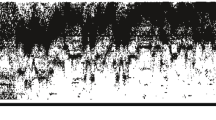Abstract
The instrument recognition system described in this paper classifies isolated monophonic musical instrument sounds using six features: cepstral coefficients, constant Q transform frequency spectrum, multidimensional scaling analysis trajectories, RMS amplitude envelope, spectral centroid and vibrato. Sounds from nineteen instruments of definite pitch, covering the note range C3–C6 and representing the major musical instrument families and subfamilies were used to test the system. Nearest neighbor classification was utilised and results were evaluated in terms of accuracy and reliability. Using the leave-one-out test strategy yielded an accuracy of 93% in instrument recognition, 97% in instrument family recognition, and 100% for sustain/impulsive instruments.
Similar content being viewed by others
References
Agostini, G., Longari, M., and Pollastri, E. (2001). Musical Instrument Timbres Classification with Spectral Features, In 2001 IEEE Fourth Workshop on Multimedia Signal Processing (pp. 97–102).
Agostini, G., Longari, M., et al. (2003). Musical Instrument Timbres Classification with Spectral Features, Eurasip J Appl Signal Process, 2003(1), 5–14.
Brown, J.C. (1991). Calculation of a Constant Q Spectral Transform. Journal of the Acoustical Society of America, 89, 425–434.
Brown, J.C. (1999). Computer Identification of Musical Instruments Using Pattern Recognition with Cepstral Coefficients as Features. Journal of the Acoustical Society of America, 105, 1933–1941.
Duda, R.O. and Hart, P.E. (1973). Pattern Classification and Scene Analysis. Wiley-Interscience.
Eronen, A. and Klapuri, A. (2000). Musical Instrument Recognition using Cepstral Coefficients and Temporal Features. In Proceedings 2000 IEEE International Conference on Acoustics, Speech, and Signal Processing ICASSP ‘00, Vol. 2 (pp.753–756).
Eronen, A. (2001). Comparison of Features for Musical Instrument Recognition. In 2001 IEEE Workshop on the Applicationis of Signal Processing to Audio and Acoustics (pp. 19–22).
Eronen, A. (2003). Musical Instrument Recognition Using ICA-Based Transform of Features and Discriminatively Trained HMMS, Signal Processing and Its Applications, 2003. In Proceedings. Seventh International, Symposium Vol. 2 (pp. 133–136).
Fujinaga, I. and MacMillan, K. (2000). Realtime Recognition of Orchestral Instruments, In Proc. Int. Comp. Music Conf. 2000 (pp. 141–143).
Handel, S. (1995). {Timbre Perception and Auditory Object Identification}. In B.C.J. Moore, (Ed.), Hearing. New York: Academic Press.
Hourdin, C., Charbonneau, G., et al. (1997). {A Multidimensional Scaling Analysis of Musical Instruments’ Time-Varying Spectra}. Computer Music Journal, 21(2), 40–55.
Jollife, I.T. (1986). Principal Component Analysis. Springer-Verlag.
Kaminskyj, I. (1998). Automatic Musical Vibrato Detection System. In Proceedings ACMA Conference (pp. 9–15).
Kaminskyj, I. (2001). Multidimensional Scaling Analysis of Musical Instrument Sounds’ Spectra. Mikropolyphonie WWW Journal, Vol. 5, Melbourne, Australia.
Kitahara, T., Goto, M., et al. (2003). Musical Instrument Identification Based on F0-Dependent Multivariate Normal Distribution, Acoustics, Speech, and Signal Processing. In Proceedings. (ICASSP ‘03). IEEE International Conference, Vol. 5 (pp. V-421–V-424).
Kostek, B. (2004). Musical Instrument Classification and Duet Analysis Employing Music Information Retrieval Techniques. Proceedings of The IEEE, 92(4), 712–729.
Kostek, B. and Czyzewski, A. (2001). Representing Musical Instrument Sounds for Their Automatic Classification. Journal Audio Engineering Society, 49(9), 768–785.
Kostek, B., Szczuko, P., Zwan, P., and Dalka, P. (2005). Processing of Musical Data Employing Rough Sets and Artificial Neural Networks. Transactions on Rough Sets, LNAI, 2005 (in print).
Martin, K.D. and Kim, Y.E. (1998). Musical Instrument Identification: A Pattern-Recognition Approach, 136th Meeting. Journal of the Acoustical Society of America, 103(3 pt 2), 1768.
Pandya, A.S. and Macy, R.B. (1996). Pattern Recognition with Neural Networks in C++. CRC Press.
Slezak, D., Synak, P., et al. (2002). KDD-Based Approach to Musical Instrument Sound Recognition, In Foundations of Intelligent Systems. 13th International Symposium, ISMIS 2002. Proceedings (pp. 28–36). Lecture Notes in Computer Science, Vol. 2366. Berlin, Germany: Springer-Verlag, 2002.
Wieczorkowska, A., Wroblewski, J., {et al}. (2003). Application of Temporal Descriptors to Musical Instrument Sound Recognition. J Intell Inf Syst, 21(1), 71–93.
Zhang, T. (2001). Instrument Classification in Polyphonic Music Based on Timbre Analysis. In Proceedings of SPIE—The International Society for Optical Engineering, Vol 4519 (pp. 136–147).
Author information
Authors and Affiliations
Corresponding author
Rights and permissions
About this article
Cite this article
Kaminskyj, I., Czaszejko, T. Automatic Recognition of Isolated Monophonic Musical Instrument Sounds using kNNC. J Intell Inf Syst 24, 199–221 (2005). https://doi.org/10.1007/s10844-005-0323-7
Received:
Revised:
Accepted:
Issue Date:
DOI: https://doi.org/10.1007/s10844-005-0323-7




